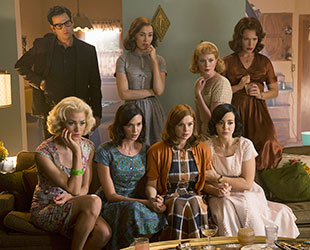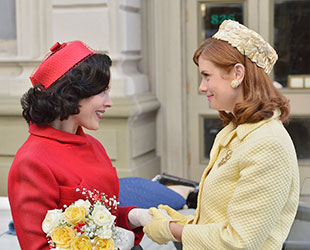 advertisements advertisements
|

|
'The Astronaut Wives Club': Space history vs. Hollywood in Episode 2 'Protocol'

"The Astronaut Wives Club" second episode "Protocol" revolved around NASA's second and third manned spaceflights. (ABC) |
June 26, 2015 — "The Astronaut Wives Club," ABC's ten-part docu-drama about the spouses behind America's first spacemen, entered orbit Thursday night (June 25) with its second episode.
Picking up where the premiere "Launch" left off, "Protocol" revolved around the second and third U.S. manned space flights from the perspectives of the astronauts' wives.
"As Louise and Alan Shepard bask in the success of his mission, Betty Grissom preps for Gus' launch and turns to Louise for advice," wrote ABC in its synopsis. "And Annie Glenn grapples with her stutter, anticipating that the press will want to hear from her after John's orbit is completed."
Grissom launched on the sub-orbital Mercury-Redstone 4 mission, flying the same trajectory as Shepard's feat from three months earlier. Glenn then lifted off more than half a year later on board Mercury-Atlas 6, making history as the first American to circle the Earth.
The one-hour episode spanned the space race's events of mid-1961 through March 1962, sometimes compressing — and sometimes stretching — the timeline to intertwine the Grissom and Glenn stories.

Azure Parsons as Annie Glenn (left) and JoAnna Garcia Swisher as Betty Grissom in "The Astronaut Wives Club." (ABC) |
"Protocol" ended with a cliffhanger, at least for anyone not familiar with the history, as the next astronaut slated to go up, Deke Slayton, revealed to his wife, Marge, that he had been grounded. But was it his fault, or hers?
Post-mission debriefing: Here is a look at where "Protocol" was faithful to space history ("A-OK!") and where it veered off course ("ABORT!").
"Private dick." As the episode opens, Marge (Erin Cummings) gets a surprise visit by Anthony Pantos (P.J. Marshall), a private detective snooping for the tabloid "Confidential," who is threatening to expose her secret first marriage.
ABORT! While it is true Marge was a divorcee, and she and Deke (Kenneth Mitchell) were keeping that quiet to avoid scrutiny, there does not appear to be record of a private eye chasing the story, including in author Lily Koppel's "The Astronaut Wives Club," which served as the basis for the series.
"There is a certain degree of creative license taken in the story, specifically having to do with the wives and a big part of that is that their lives were not well documented, at least not in a factual way, as much as the men were," Cummings told collectSPACE.
"Adding the window." Trudy Cooper (portrayed by Odette Annable) mentions the addition of a window to Grissom's capsule. "With that window, he's going to be first man to really see the Earth from space."
A-OK! As dramatized in "The Right Stuff," the large window was added at the astronauts' own request. As Grissom radioed to the ground on July 21, 1961, "It is such a fascinating view out the window, you just can't help but look out that way." He described viewing the panorama that was the Earth's horizon and seeing Cape Canaveral laid out below.
Soviet cosmonaut Yuri Gagarin, who beat Shepard into space, only had a small porthole to look out his Vostok spacecraft. Shepard's situation was similar, though he also had a periscope to extend his view out of the small opening down through his legs.
"Liberty Bell is sinking." Betty Grissom (JoAnna Garcia Swisher) and the other wives are elated Gus (Joel Johnstone) splashed down safely after his 15-minute spaceflight, but that delight turns to concern when its reported his capsule is taking on water.
A-OK! Today you can see Liberty Bell 7 on display at the Kansas Cosmosphere, but that is only due to the museum's efforts to find and raise the capsule off the ocean floor 38 years after it was lost.
Soon after landing, the capsule's hatch blew, letting the ocean rush in. Grissom was ultimately rescued, but his capsule, now flooded, was too heavy for the recovery helicopter's lifting capacity and and it was cut loose to sink.
"Why don't you just turn the car around?" In the wake of losing Liberty Bell 7 and the public scrutiny over whether it was Grissom's fault, Gus and Betty are denied visting the White House. Instead, NASA arranges for a beach house vacation for the couple and their two boys. Frustrated by the situation, the two agree to turn their car around and head back to the Cape.
ABORT! (but not by much) As Lily Koppel recounts in her book, Gus and Betty drove all the way to the beach house, located near Patrick Air Force Base, where Betty found a stocked fridge. "What do these people think I am going to do?" she told Gus. "I am not going to cook!"
The scene that follows the Grissom's U-turn on the show is more consistent with history, according to Koppel. After leaving the beach house, Gus drove Betty to the Cape, where he showed her the uncut film footage of his troubled recovery, revealing he'd struggled to avoid sinking himself.
"Glenn, you're grounded." After an overcast sky scrubs his launch, John Glenn (Sam Reid) gets a call from a distressed Annie (Azure Parsons), who, because of her stutter, does not want to meet with President Lyndon Johnson — and the TV cameras following him. Glenn, ignoring NASA's demand that the visit go forth and the threat of being replaced on the flight, sides with Annie.
A-OK! ...and ABORT! Johnson was indeed turned away from consoling Annie at the Glenns' home on Jan, 27, 1962, and Glenn does recall that someone from NASA threatened to pull him off the flight as a result. But here is where his account and the show parts ways.
The series shows the other astronauts refusing to fill Glenn's seat, leaving NASA with no other option than Glenn. Glenn, however, recounted it differently in his memoir published in 1999.
"I said that if they wanted [to replace me], they'd have a press conference to announce their decision and I would have one to announce mine, and if they wanted to talk about it anymore, they'd have to wait until I took a shower. When I came back, they were gone and I never heard any more about it."
"It was the external release lanyard." At the New York ticker tape parade for John's successful flight, Gus announces to Betty, "They cleared me. They finished the investigation. It is officially fact that if I had blown the hatch, my hand would have been all back and blue."
ABORT! As mentioned at the start, "Protocol" is a bit loose with the timeline of real events and in Gus' short speech, he jumps between findings from the past and future. First though, it should be clarified that NASA never held Gus culpable for the hatch or Liberty Bell 7 sinking. As such, there never was an occasion for Grissom to be cleared.
But that aside, NASA's investigation into the hatch was concluded in August 1961, a full eight months before the March 1, 1962 parade. And a definitive cause was never declared. There were a number of theories — including the exterior lanyard becoming entangled with the landing bag straps — which is what Grissom said he thought happened in a 1965 interview.
(As for the black and blue, that's true but it was not until Wally Schirra purposely blew his hatch seven months after the parade that he showed the danger of being injured.)
"The Astronaut Wives Club" collectSPACE reviews:
-
Episode 2 - "Protocol" (June 25) -
-
-
-
-
-
-
|

© 1999-2025 collectSPACE. All rights reserved.

|
|

|

|
